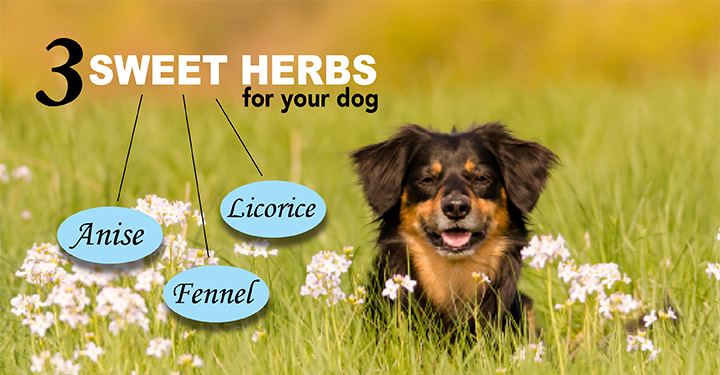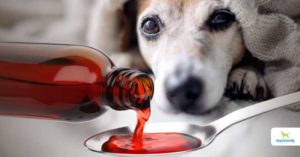Anise, fennel and licorice. These three delicious culinary and medicinal herbals are common ingredients in foods, treats and herbal remedies. With a little explanation, you’ll understand why they are commonly confused and how you can choose which to use for your pet.
Anise, fennel and licorice are three entirely different plants, but they all have similar taste properties. They are all sweet and aromatic. This often leads to confusion when eating products that contain any one of them.
Anise
Anise is an herb that’s quite often used in western herbal products. The seed and the oil are used more often than the root or leaf.
Anise (Pimpinella anisum), is in the aster or daisy family. Some call this Roman Fennel. Its flowers are star-shaped and it is commonly called star anise.
Anise is a remedy for several ailments including:
- intestinal gas
- upset stomach
- runny nose
- cough
- urine flow
- appetite stimulation
- seizures
- asthma
- constipation
The oil is used in products for external parasitic and other skin conditions.
The natural chemical constitution of anise oil is 80 to 95 percent anethole, a phenolic ether. Phenolic ethers are strong in fragrance and in action. Anise oil is rich in both phenolics and phenylpropanoids which can perform several important functions in the body – cleansing receptor sites, eating up free radicals and protecting your pet from harmful viruses and bacteria. Additionally, other natural chemical constituents in anise can have estrogen-like effects and insecticidal properties.
Fennel
Fennel seeds are the Ayurvedic herbal seeds commonly found at the exit of Eastern Indian restaurants. They are healthy “after dinner mints”. They are consumed for their digestion-enhancing and breath-freshening properties.
Fennel (Foeniculum vulgare) is a member of the parsley family and the crushed seeds can be steam distilled to release the essential oil. Consumption of the oil can promote healthy digestion.
It expels worms and has antiseptic, antispasmodic and analgesic properties. It is used in mouthwashes, toothpastes and even dog treats!
Try fennel for these conditions:
- indigestion
- nausea
- intestinal spasms
- parasites
The natural chemical constitution of fennel oil is 50 to 70 percent anethole, the same phenolic ether that exists in an even higher concentration in anise. Anise and fennel oils are interchangeable in the practice of aromatherapy. Other chemistry in anise makes it a better choice if a diuretic or stimulant is desired. The chemistry in fennel makes it a better choice to facilitate birthing or enhance lactation.
Licorice
Licorice is the great “harmonizer” in many Chinese herbal formulas. It helps other herbs blend together. It makes the overall formula more palatable, especially for pets, and is soothing to the tummy!
Licorice (Glycyrrhiza glabra) is the sweet herb used in the manufacture of real licorice candy, although many candies labeled as licorice use the copycat flavor of anise instead.
Licorice can be beneficial for some of the following conditions:
- arthritis and joint pain
- digestive issues
- liver health, detoxification and support
- respiratory issues with mucus membrane involvement
- urinary tract infections
There is also recent evidence that phytoestrogens exert beneficial actions on chronic diseases such as cardiovascular problems, osteoporosis and Alzheimer’s disease. Researchers reported licorice to be effective against Helicobacter pylori, the bacterium responsible for stomach ulcers. The same paper states, “aqueous solutions of some kinds of licorice saponins solubilize water-insoluble substances such as α-tocopherol (Vitamin E) and oleanolic acid (a fatty acid).” This affirms the long-held Chinese assertion that licorice harmonizes or blends other formula constituents together.
In dogs, hypoadrenocorticism or Addison’s disease is somewhat common, but underdiagnosed. It is often called the “ain’t doin’ right” disease. Classic symptoms of Addison’s can be seen in a dog who is stressed by going to the groomer or the vet and may develop diarrhea or nausea, which usually passes on its own. If Addison’s is diagnosed (through an ACTH stimulation test), licorice is a potential treatment.
Most pets love licorice root because it is naturally sweet. Some say it is about 50 times as sweet as sugar. Thankfully it is a zero on the glycemic index, so there are no sugar calories or insulin- spiking impact! If your pet enjoys licorice, you can combine the extract periodically, in tiny amounts, with other herbal supplements to entice consumption.
Caution: Licorice consumption can affect the body’s production of cortisol, which helps the body manage stress and proper immune function. A licorice metabolite (GA) inhibits the enzyme responsible for inactivating cortisol (known as 11β-hydroxysteroid dehydrogenase type 2). Long term consumption of large doses of licorice extract can lead to hypokalemia (low potassium) and serious hypertension (high blood pressure).
Dosing
Pet products containing fennel, anise or licorice generally list dosing instructions depending on their concentration and whether or not they are mixed with other ingredients. The potency varies depending on whether the product is whole ground herb, an extract, granular concentrate or even an essential oil version of the herb, so it’s best to follow the manufacturer’s instructions. If you buy human products, the dosing instructions are based on a 150 lb human, so just adjust the dosage for your dog’s weight. This is a standard way to dose herbs and can be used for other herbal products as well.
References
- David Stewart Ph.D., D.N.M. The Chemistry of Oils Made Simple
- Essential Oils Integrative Medical Guide D. Gary Young ND
- Pure Appl. Chem., Vol. 74, No. 7, pp. 1199–1206, 2002
- http://www.sugar-and-sweetener-guide.com/glycyrrhizin.html












